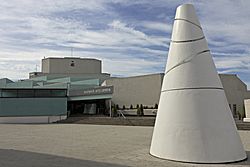Warwick Arts Centre facts for kids
Warwick Arts Centre is a large and exciting place for arts and entertainment. It is located at the University of Warwick in Coventry, England. Every year, about 300,000 people visit to enjoy over 3,000 different events. These events include theatre, live shows, modern and classical music, dance, comedy, art exhibitions, films, and talks. There are also many fun events for families. Warwick Arts Centre is the biggest arts centre in the Midlands. It is also the largest of its kind in the UK, apart from the Barbican Centre in London.
The centre has many different spaces all in one place. These include a big concert hall that can hold 1,500 people and a theatre. There are also three cinemas, an art gallery called Mead Gallery, and the Helen Martin Studio. You can also find learning spaces, places for events, a café, and bars. The University of Warwick Music Centre is also here, with practice rooms and a rehearsal space for music groups.
Contents
History of Warwick Arts Centre
The idea for the Arts Centre came from Jack Butterworth, the first vice-chancellor of the university. He worked with an American supporter named Helen Martin.
Building and Early Years
The Arts Centre was planned in 1970 and first opened its doors in October 1974. It was designed by architects Renton, Howard, Wood Associates. The building even won an award for its design. When it first opened, it had a theatre, a smaller studio theatre, a meeting room, and a music centre.
More spaces were added later. The larger Butterworth Hall opened in 1981. The Mead Gallery and a cinema were added in 1986.
Modern Upgrades and Reopening
Warwick Arts Centre went through a big renovation project that lasted four years. This was the largest upgrade in its history. The centre reopened for events in October 2021. The work included improving the existing spaces and adding a new main entrance area. Three new cinemas and a new restaurant were also built.
In January 2022, the Mead Gallery reopened in a new spot. It is now the largest dedicated space for modern art exhibitions in the region. It has a floor area of about 6,458 square feet.
50th Anniversary Celebration
In autumn 2024, Warwick Arts Centre celebrated its 50th birthday. They had a special program called "Rebels With A Cause!" This program celebrated creativity in the community and how art can bring about change.
Mead Gallery: A Place for Art
The Mead Gallery is Warwick Arts Centre's special place for showing visual art. It first opened in May 1986. The gallery was named after Phil Mead, a businessman from Coventry. He helped gather support for the University and the Arts Centre.
What You Can See at Mead Gallery
The Mead Gallery is a large, L-shaped space. It has three white rooms that can be used as separate galleries. When it first opened, it showed two exhibitions. One was called Surprises In Store: Fifty Years of British Art. It featured works by famous artists like Barbara Hepworth and Bridget Riley. The other exhibition showed stage designs and sculptures by Fernand Léger.
Over the years, many other famous artists have shown their work at the Mead Gallery. These include sculptors like Henry Moore and Elisabeth Frink. Photographers like Bill Brandt and Dorothea Lange have also had their work displayed. The gallery has also featured artists such as Tracey Emin, Grayson Perry, and Olafur Eliasson.
The gallery closed in 2018 for the big renovation project. It reopened in January 2022 with an exhibition called Rana Begum: Dappled Light.
The Koan: A Unique Sculpture
Outside the Arts Centre, there is a very special sculpture called White Koan. It was created by the American-born artist Liliane Lijn. The university bought it in 1972.
The sculpture is a cone shape that spins and has lights. It mixes industrial materials with artistic ideas. Liliane Lijn is known for exploring how art, science, technology, and Eastern ideas connect.
Fun Myths About The Koan
Some fun stories have grown around the sculpture since it was put there. One myth says it was the nose cone from a failed Apollo space mission. Another story suggests there are several nightclubs hidden underneath it!
The White Koan is part of the Sculpture Park at the university. This park also features artworks by other artists like Richard Deacon and Laura Ford.
Famous Visitors
Many well-known people have visited Warwick Arts Centre over the years. These include authors like Terry Pratchett and actors such as Jeremy Irons and Hugh Laurie. Famous comedians like Jimmy Carr and Eddie Izzard have also performed there.
Musicians and groups like City of Birmingham Symphony Orchestra, Chineke! Orchestra, The Smiths, Kirsty McColl, Yehudi Menuhin, Kiri Te Kanawa, Nigel Kennedy, and Evelyn Glennie have graced its stages. The centre has been called "one of the best places in the Midlands to watch theatre, comedy and other shows." It is truly a "vibrant showcase for the very best in contemporary art, events and entertainment."



